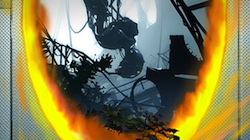Hey game fans, welcome back. In honor of the release of Portal 2 and the return of the wicked GLaDOS, yesterday Tor.com counted down the five best villains in video game history. Today, we will be counting down the Five Most Overrated Villains in video game history. We were going to do a Top Five Worst list, but since those awful tedious boss battles are all in games we hate, we will instead examine popular villains who have been getting off the hook for a little too long.
5. The Jefferson Memorial – Fallout 3
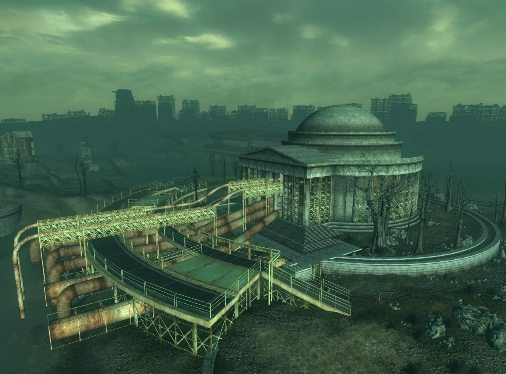
The villain…is free will.
Fallout 3 shook the industry with its innovative gameplay and fully realized post-apocalyptic world. The retro-futurism never misses a beat, and players found themselves immersed for countless hours, fighting ghouls, robots, and vampires, and disarming (or detonating) nuclear bombs. There is even an ominous villain, the Enclave President John Henry Eden, played with his usual diabolical flair by Malcolm McDowell (although why the President of the United States in the future is British, I guess we will never know).
In a shocking third act twist, it is revealed that President Eden is not a man at all, but a supercomputer programmed with the personalities of past presidents. (Maybe we could set him up on a cyber date with GLaDOS?) Eden asks the player to commit genocide so that mankind can live on only in its purist form. There is no intense battle here. Just a conversation with a talking TV monitor. If you tell Eden to blow himself up, or erase his memory banks, he will. It is fiercely anti-climactic.
The game does not end there, however, and the finale becomes even more underwhelming. With the help of the Brotherhood of Steel and an iron giant called Liberty Prime, the player infiltrates the Jefferson Memorial to release clean water across the DC wasteland. But there is one problem. The room with the release mechanism is flooded with deadly radiation, and the building is about to explode! The final battle becomes, essentially, a moral question. Will the player sacrifice his own life to save the wasteland? He can kill himself, or tell some woman he barely knows to do it, or he can tell his friend the super mutant (who is immune to radiation) to do it. Not much of a moral argument, is it? The player tells his radiation-resistant friend to turn on the purifier. The mutant obliges, giving the machine a kick for good measure.
Least. Climactic. Ending. Ever.
4. Arcturus Mengsk – Starcraft
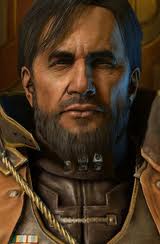
Meet the new boss, same as the old boss.
Emperor Mengsk began his career as a revolutionary, fighting the oppressive Terran Confederacy. To help him, he enlisted a ragtag band of rebels including Raynor, a space marshall, Kerrigan, a telepathic assassin, and Duke, a former Confederate general. But once his victory was assured, Mengsk betrayed his allies and appointed himself Emperor of a new galactic civilization, the Dominion.
It all seems good, right? He is the puppet master pulling the strings. He even created another supervillain—when Kerrigan was left to die in a war zone, the Zerg turned her into the Queen of Blades. But Mengsk is a bland coward. It has been fourteen years since we first met Mengsk, but never once has he taken the field. Players are never allowed to fight him directly.
In Starcraft 2, Mengsk is presented as the big bad, but just like in past games, the other villains overshadow him. Mengsk is totally forgotten in the first game once the threat of the Overmind appears. Kerrigan and Duran are much cooler (and more frightening) in Brood War. Even Mengsk’s pageboy son Prince Valerian has more screen time in Starcraft 2.
Palpatine this guy is not. More like Darth Also-ran.
3. Ganon – The Legend of Zelda
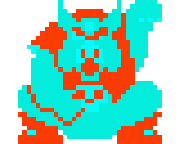
Well excuuuuuuuuuse me, princess.
An evil ugly wizard kidnaps a princess. A good handsome boy with a sword rescues her. That is the plot of countless games. The Legend of Zelda may not have started the trend, but it certainly popularized it. Calling it a cliché would be an understatement.
Not to say that Ganon does not have his merits. Supposedly based on the man-pig Zhu Bajie from the classic Chinese novel Journey to the West, Ganon is the antithesis of Link — enormous, powerful, a monster. My image of him was shaped by the original game, when Ganon appeared as a big blue demonic boar-man, like something out of Dante’s Inferno or Teenage Mutant Ninja Turtles. I recall my disappointment when he appeared as Ganondorf (Ganondork) in Ocarina of Time, only to be completely blown away by one of the greatest “Oh !@#$%” moments in video game history, when Ganondorf transforms into the gigantic sword-wielding monstrosity Ganon.
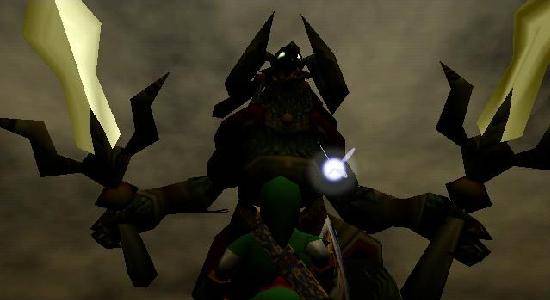
At the time Ganon was one of the largest monsters ever encountered in a game. He looks remarkably like a Colossus in size and shape, but Ocarina of Time predates Shadow of the Colossus by a good eight years.
If all of this sounds like an argument for why Ganon is one of the best video game villains ever, it is because he is one of the best. Like Bowser, Ganon has an untouchable place in video game history.
But Ganon is bad for us. He represents a screwed up psychology that has corrupted generations of children. Why are the wizards (smart people) always bad, and the warriors (strong people) always good? Why does might make right? In much the same way that Disney princesses have encouraged generations of girls to expect a prince to solve all their problems, games like The Legend of Zelda teach boys an anti-intellectual philosophy. Don’t study. Don’t learn magic. If you see an obstacle, hit it with your stick. Kill everything on the board. Sometimes there are rewards for that.
This warrior vs. wizard phenomenon has reached critical mass. Prince of Persia, Castlevania… Look at the Dissidia games, which pit Final Fantasy heroes and villains against each other in single combat. Nine of the ten heroes have swords. Seven of the ten villains are wizards. The other three use magic.
There will always be a place for evil wizards, and boys with sticks to fight them in their backyards. But as gamers mature, so should their villains. We deserve better.
2. Liquid Snake – Metal Gear Solid
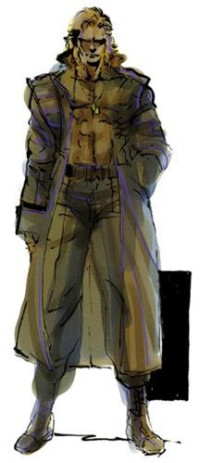
It’s Alaska, put your dang shirt on!
Liquid is another villain who sounds good on paper. He is the evil twin of the world’s greatest soldier, a devious mastermind with plans to…wait a minute, what was Liquid’s objective? You would think that after 25 minutes of cutscene monologues, explaining his history and motivations, that players would have some idea of what Liquid’s goal was. Something about sabotaging the START treaty, or starting a war between the U.S. and Russia. Why? I have no idea. I’ve played this game a dozen times on three systems and it still doesn’t make sense.
Also, Jacob from Twilight wears more shirts than this jerk.
He should be called Liquid Cat, considering how many lives this guy has. In the first game alone, he is in a helicopter struck by no fewer than a dozen stinger missiles and survives the following crash. He blows up inside a giant walking battle tank, then gets punched out by his brother Solid Snake and falls off the wreck of the aforementioned battle tank. Then he chases Solid Snake through a narrow tunnel in a jeep, gets shot by an automatic rifle about 5,000 times, and crashes the jeep on a snowy cliff. And then, finally, Liquid Snake dies of… a virus? Seriously? After all that torture, players don’t even get to kill Liquid. He just falls over. It’s the video game equivalent to the ending of War of the Worlds.
To add insult to injury, Liquid returns in the sequel, tarnishing Revolver Ocelot, a villain who is actually cool. In the first game, Ocelot loses a hand, so in the sequel he has the dead Liquid’s hand grafted onto his arm. Somehow, this transfers Liquid’s personality and memories into Ocelot, guaranteeing many more sequels with monologue cutscenes so long they require cutaways to stock footage.
1. Sephiroth – Final Fantasy VII
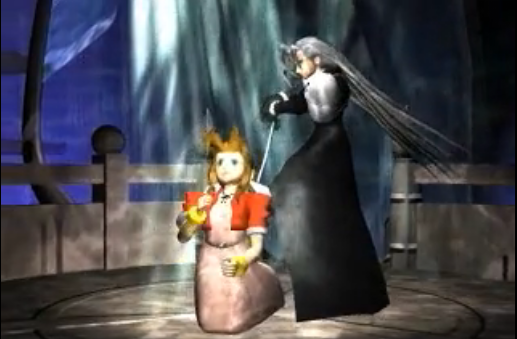
Surprised?
Sephiroth is famous because he stabs a girl in the back. Maybe if I had not been on Team Tifa from the start I would have cared more, but Aeris was always a bit saccharin for my taste.
People love Sephiroth because he is tall, dark, and handsome, but his totally illogical goals (“I am going to destroy the world so I can be the most powerful being in the world!”) make him the most overrated villain of all time.
He has his moments. After a lecture from the president of the evil Shinra Company, Cloud and the other heroes are thrown into a jail cell and fall asleep. When they wake, the cell doors are open, the guards are dead, and the walls are smeared with blood. The heroes make their way to the president’s office, where the old man (the arch-villain up to this point) lies dead, a big sword sticking out of his back. Cloud observes that only the mysterious SOLDIER Sephiroth could be responsible for this carnage. The first time I saw him, in a flashback, huddled in the rear of a truck, mako eyes glowing, I got chills. On my first playthrough, after watching my party get decimated by the Midgar Zolom, a giant swamp serpent, I reached the other side of the swamp and saw a huge tree hewn into a spike, the serpent’s head skewered. Lightning flashed. We have to fight someone who can do that? Really? Gulp!
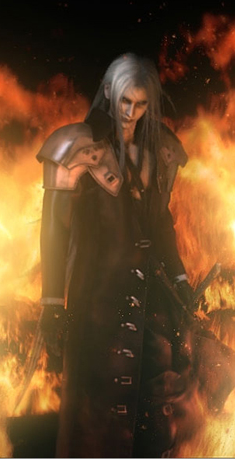 But it is all down hill from there. Confusing plots with clones, mind control, a side story with his mother, and another side story with a different mother, all muddle who or what Sephiroth is. What role does JENOVA play? Who is controlling who? It’s ambiguous in the original translation, and incomprehensible if you don’t watch all the hidden cutscenes.
But it is all down hill from there. Confusing plots with clones, mind control, a side story with his mother, and another side story with a different mother, all muddle who or what Sephiroth is. What role does JENOVA play? Who is controlling who? It’s ambiguous in the original translation, and incomprehensible if you don’t watch all the hidden cutscenes.
In another Act III twist, it is revealed that Sephiroth has actually been encased in materia at the North Crater the entire game. Okay, that’s fine. Then who have we been chasing since we left Midgar? Cloud’s spiritual manifestation? A phantasm? Then who killed President Shinra and the Midgar Zolom?
I will embrace a new translation of this game with open arms, because currently it does not make one lick of sense.
Matt London is an author and filmmaker who lives in New York City. He is a graduate of the Clarion Writer’s Workshop. He writes about video games and other stuff for Tor.com, Fantasy Magazine, Lightspeed, and Realms of Fantasy. His fiction is out right this second in the anthology The Living Dead 2. Follow him on Twitter.










